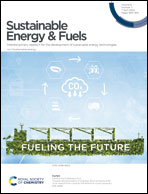Efficient electrocatalytic H2 evolution mediated by 2D Janus MoSSe transition metal dichalcogenide
Abstract
2D Janus transition metal dichalcogenides (JTMDs) with asymmetric electronic structures have recently attracted intense research interest in modern science and technology. Using the first-principles-based periodic hybrid dispersion-corrected density functional theory (DFT-D) method, we have investigated the equilibrium structure, geometry, and electronic properties of the 2D monolayer MoSSe JTMD with regards to its electrocatalytic activity for the H2 evolution reaction (HER). We have performed non-periodic quantum mechanical DFT computations to find out the most favorable HER pathway on the exposed surfaces of the 2D Janus MoSSe material, i.e., on the Mo-edges (10![[1 with combining macron]](https://www.rsc.org/images/entities/char_0031_0304.gif) 0) and S-/Se-edges (
0) and S-/Se-edges (![[1 with combining macron]](https://www.rsc.org/images/entities/char_0031_0304.gif) 010). To explore the electrocatalytic HER mechanism, reaction pathways and barriers, we have considered a cluster model system Mo10S12Se9 to illustrate the Mo-edges (10
010). To explore the electrocatalytic HER mechanism, reaction pathways and barriers, we have considered a cluster model system Mo10S12Se9 to illustrate the Mo-edges (10![[1 with combining macron]](https://www.rsc.org/images/entities/char_0031_0304.gif) 0) and S-/Se-edges (
0) and S-/Se-edges (![[1 with combining macron]](https://www.rsc.org/images/entities/char_0031_0304.gif) 010) of the 2D monolayer MoSSe material. The present study reveals that the Volmer–Heyrovsky reaction mechanism is a thermodynamically favorable reaction pathway to produce H2 at the Se-terminated Mo-edges. It was found that the change of the free energy barrier (ΔG) during the Heyrovsky reaction at the Se-terminated Mo-edges is about 3.93–7.10 kcal mol−1 (in both the gas and solvent phases), indicating that it is an exceptional electrocatalyst for HER with a very low activation barrier. This study showed that the Tafel slope (m) is lower in the case of the 2D Janus MoSSe material due to the overlap of the s-orbital of hydrogen and d-orbitals of the Mo atoms appearing in the HOMO and LUMO transition state TS1 of the H˙-migration reaction step. A better overlap of the s-orbitals of the hydrogen atom attached to Mo and the water cluster (H3O+ + 3H2O) seen in the HOMO–LUMO Heyrovsky transition state TS2 has been found, and this overlap of atomic orbitals during H2 formation in the Heyrovsky TS2 reduces the reaction barrier. The better stabilization of the atomic orbitals in the HER rate-limiting step, i.e., the H˙-migration TS1 reaction step (in the solvent phase), is the key to reducing the reaction barrier. Thus, the overall catalysis indicates a better electrocatalytic performance for H2 evolution. The present investigation shows how to computationally invent a highly reactive 2D electrocatalyst from JTMDs using their exposed edges, which are active, for effective HER. This study will enhance the development of 2D JTMDs with lower reaction barriers during H2 evolution.
010) of the 2D monolayer MoSSe material. The present study reveals that the Volmer–Heyrovsky reaction mechanism is a thermodynamically favorable reaction pathway to produce H2 at the Se-terminated Mo-edges. It was found that the change of the free energy barrier (ΔG) during the Heyrovsky reaction at the Se-terminated Mo-edges is about 3.93–7.10 kcal mol−1 (in both the gas and solvent phases), indicating that it is an exceptional electrocatalyst for HER with a very low activation barrier. This study showed that the Tafel slope (m) is lower in the case of the 2D Janus MoSSe material due to the overlap of the s-orbital of hydrogen and d-orbitals of the Mo atoms appearing in the HOMO and LUMO transition state TS1 of the H˙-migration reaction step. A better overlap of the s-orbitals of the hydrogen atom attached to Mo and the water cluster (H3O+ + 3H2O) seen in the HOMO–LUMO Heyrovsky transition state TS2 has been found, and this overlap of atomic orbitals during H2 formation in the Heyrovsky TS2 reduces the reaction barrier. The better stabilization of the atomic orbitals in the HER rate-limiting step, i.e., the H˙-migration TS1 reaction step (in the solvent phase), is the key to reducing the reaction barrier. Thus, the overall catalysis indicates a better electrocatalytic performance for H2 evolution. The present investigation shows how to computationally invent a highly reactive 2D electrocatalyst from JTMDs using their exposed edges, which are active, for effective HER. This study will enhance the development of 2D JTMDs with lower reaction barriers during H2 evolution.



 Please wait while we load your content...
Please wait while we load your content...